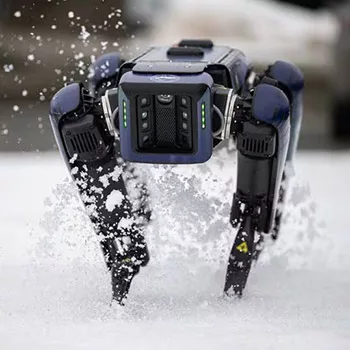It’s not every day that you see a fox or coyote patrolling an airport runway, but that’s about to change at a major US airport, thanks to an innovative robotic solution designed to keep wildlife at bay.
Introducing Aurora, the Robotic Wildlife Deterrent
At a glance, you might mistake it for just another animal, but Aurora is actually a cutting-edge robot that’s set to take up residence at Fairbanks Airport, Alaska’s second-largest aviation hub. This headless, quadrupedal machine bears the size and shape of a Labrador but comes with a lifesaving mission: to prevent potentially hazardous wildlife encounters on the runways.
Its role is straightforward but pivotal—for protection and operational efficiency, Aurora will mimic the presence of predatory animals like coyotes or foxes to deter birds and other creatures from nesting and lingering in areas that could jeopardize aircraft safety.
How Aurora Enhances Airport Safety
The ingenious use of Aurora is the brainchild of the Alaska Department of Transportation and Public Facilities. Outlined in a report by the Anchorage Daily News, the robot demonstrates agility by navigating challenging terrains and even flaunts a dancing capability—a feature that will be particularly useful during the bird migratory season to emulate predator movements and keep the skies clear for takeoff and landing.
Aurora is not just a static scarecrow but an active patrol, programmed to surveil the near-runway environments hourly, thereby reducing the risk of dangerous animal-aircraft collisions.
The Design and Functions of Aurora
The robot can alter its appearance to replicate either a coyote or a fox simply by switching its exterior panels, though these are designed to avoid the complexity of realism or the use of actual fur, ensuring Aurora’s waterproof nature.
Previous Wildlife Control Attempts
Officials have previously explored a variety of strategies, from aerial drones dispensing grape-juice-based repellents to highly unconventional methods like releasing pigs near airports, all in an effort to address wildlife hazards. However, Aurora represents a fresh approach that may yield better results and stronger deterrence against not just birds but larger animals as well.
The Future of Robots in Airports
With Aurora spearheading the intersection of robotics and wildlife management at airports, the technology could very well become a staple in airports across the country and beyond—potentially rendering human wildlife service teams obsolete, especially given the high cost of employing such teams.
Alaska has experienced numerous animal strikes—92 last year alone. While most of these incidents do not result in aircraft damage, the few that do can cause expensive and life-threatening crashes. The infamous 1995 crash of an AWACS jet in Anchorage, caused by a flock of geese, remains a stark reminder of the critical need for effective wildlife control measures.
Technological Advancements and Cost Efficiency
Aurora doesn’t come cheap, with a price tag of around $70,000, funded by a federal grant. However, if this pilot test at Fairbanks is successful, the robot could become a more economical option for smaller airfields throughout Alaska compared to their current solutions.
Operational through hand-held remote control, a computer, or on a pre-set schedule, Aurora’s movements may be autonomous, but they will always be under human supervision. Remarkably, this robot is not hindered by adverse weather conditions such as rain or snow, showcasing Boston Dynamics‘ exemplary engineering.
As airports seek new ways to ensure the safety of their operations, Aurora stands as a beacon of progress, bringing high-tech solutions to front-line wildlife management, for the safety of passengers and crew alike.
